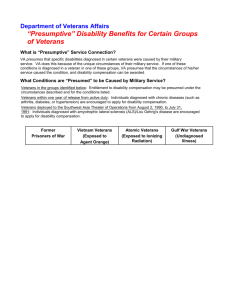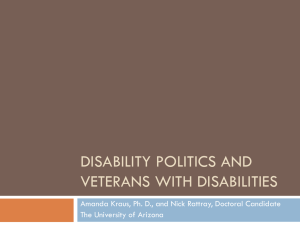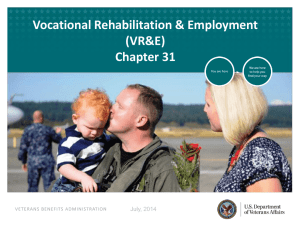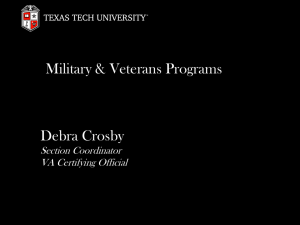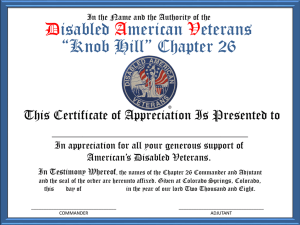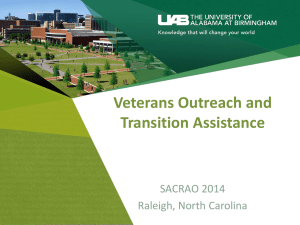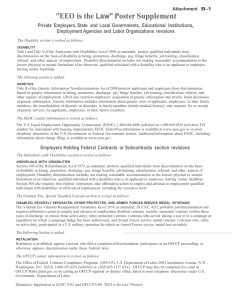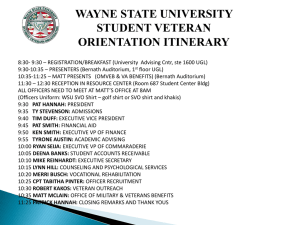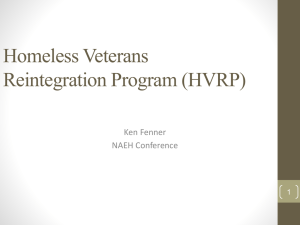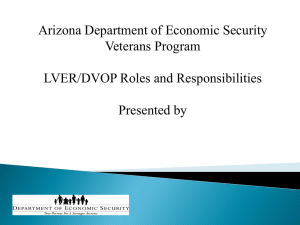Operation Integration: The culture of student veterans
advertisement
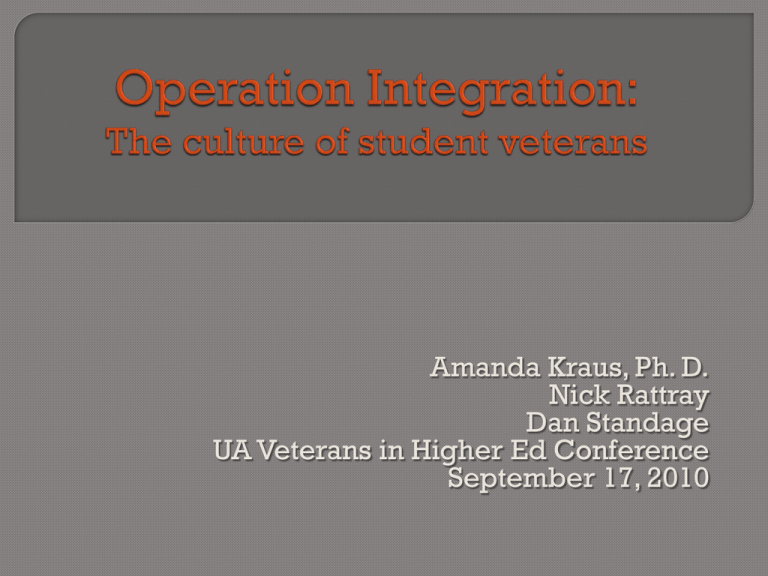
Amanda Kraus, Ph. D. Nick Rattray Dan Standage UA Veterans in Higher Ed Conference September 17, 2010 Influx of student veterans to higher education Enrollment in Community Colleges or Vocational Institutions on the rise Post-9/11 G.I. Bill expanded benefits Complex transitions to civilian life and life with disability Students with military experience make up about 4% of undergraduate students. Compared to traditional undergraduate students, veterans tend to be older and are more likely to be non-white. Although only seven percent of the armed forced were women in 2006, 27% of all student veterans in 2007-08 were women. Around half of undergraduates with military experience received veterans educational benefits at public four-year universities. In 2007-2008, 12 percent of military undergraduates attended for-profit institutions, which is a rate three times higher than traditional undergraduates. As of September 2009, the number of American troops who have been injured is 35,390, 46% of whom could return to duty within 72 hours. The rate for mental health and cognitive issues following return from deployment was 14% for major depression, 14% from PTSD, and 19% for a probable Traumatic Brain Injury (TBI). RAND estimates that the cost from PTSD-related and depression costs could range from $4.0 to $6.2 billion over two years. Philosophy on program development Disabled Veterans Reintegration and Education Project Veterans Education and Transition Services (V.E.T.S.) Initiative VETS Office Student Veterans of America at the University of Arizona SERV Classes GI Bill counseling Network of point people on and off campus PTSD support group and on-site VA counseling Veterans in Higher Education Conference Veterans in Higher Education National Clearinghouse Identity Norms Rites of passage Language Shared experiences Access issues related to higher education Cohort mentality Consider student veterans as a cultural group. How does your campus support this identity? What are the challenges associated with supporting this identity? Department of Defense disability statistics VA disability rating and benefits Physical versus “other” disabilities Self-imposed “hierarchy” Combat-related injury Service-related injury Non-service-related injury “Wounded warrior” and “battalion”– language in rehabilitation Potential of adaptive athletics Universal design of office Physical access Assistive technology on all computers Partner with DRC events Athletics Philanthropy DRC/Mental Health marketing in VETS Office First-hand referrals DRC contacts Strong relationship with local VA The social model of disability promotes disability as a sociopolitical construct, not an individual impairment. What challenges do the DOD disability statistics and the VA disability rating system pose to operationalizing the social model of disability? Disability identity? Reflect on the “hierarchy” students veterans use to make meaning of disability? What implications might this have for service provision? UA V.E.T.S. studentaffairs.arizona.edu/vets Radford, A. W. (2009). Military service members and veterans in higher education: What the new GI bill may mean for postsecondary institutions. Washington, D.C.: American Council on Education. US Department of Defense (http://www.defenselink.mil/news/casualty.pdf). Tanielian, T., & Jaycox, L. H. (2008). Invisible wounds of war : Psychological and cognitive injuries, their consequences, and services to assist recovery. Santa Monica: Center for Military Health Policy Research, RAND. U.S. Census Bureau, 2005-2007 American Community Survey.

